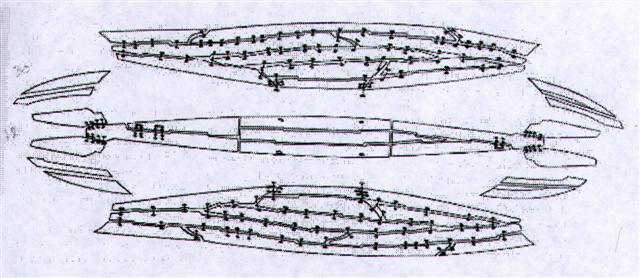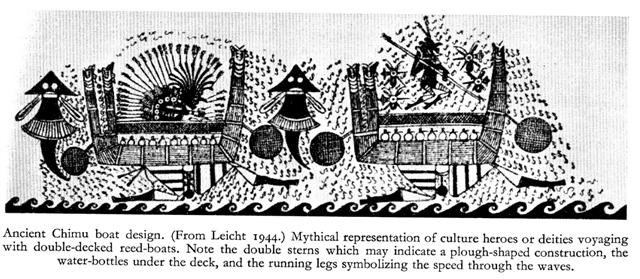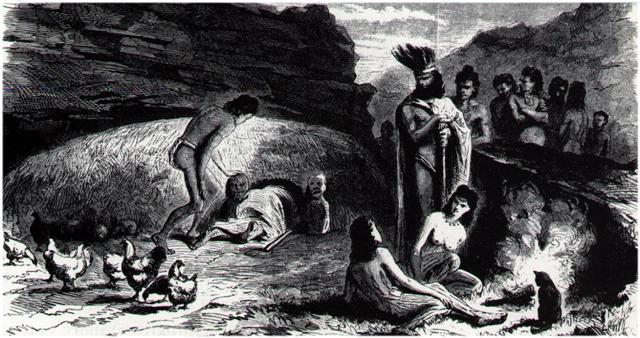|
584
56 The planet Mars had 'two faces', one when he was bright and close to Earth and the other when he had sailed far away and therefore had a faint light.
... There is a couple residing in one place named Kui and Fakataka. After the couple stay together for a while Fakataka is pregnant. So they go away because they wish to go to another place - they go. The canoe goes and goes, the wind roars, the sea churns, the canoe sinks. Kui expires while Fakataka swims. Fakataka swims and swims, reaching another land. She goes there and stays on the upraised reef in the freshwater pools on the reef, and there delivers her child, a boy child. She gives him the name Taetagaloa. When the baby is born a golden plover flies over and alights upon the reef. (Kua fanau lā te pepe kae lele mai te tuli oi tū mai i te papa). And so the woman thus names various parts of the child beginning with the name 'the plover' (tuli): neck (tuliulu), elbow (tulilima), knee (tulivae).
They go inland at the land. The child nursed and tended grows up, is able to go and play. Each day he now goes off a bit further away, moving some distance away from the house, and then returns to their house. So it goes on and the child is fully grown and goes to play far away from the place where they live. He goes over to where some work is being done by a father and son. Likāvaka is the name of the father - a canoe-builder, while his son is Kiukava ...
The left and right sides - the 'twins' - were not exactly alike, as we can see. ... Taetagaloa goes right over there and steps forward to the stern of the canoe saying - his words are these: 'The canoe is crooked.' (kalo ki ama). Instantly Likāvaka is enraged at the words of the child. Likāvaka says: 'Who the hell are you to come and tell me that the canoe is crooked?' Taetagaloa replies: 'Come and stand over here and see that the canoe is crooked.' Likāvaka goes over and stands right at the place Taetagaloa told him to at the stern of the canoe. Looking forward, Taetagaloa is right, the canoe is crooked. He slices through all the lashings of the canoe to straighten the timbers. He realigns the timbers. First he must again position the supports, then place the timbers correctly in them, but Kuikava the son of Likāvaka goes over and stands upon one support. His father Likāvaka rushes right over and strikes his son Kuikava with his adze. Thus Kuikava dies. Taetagaloa goes over at once and brings the son of Likāvaka, Kuikava, back to life. Then he again aligns the supports correctly and helps Likāvaka in building the canoe. Working working it is finished ... Vaka means a ship (a canoe, a 'living' - quickly moving - 'wood'): ... The explorers reach Easter Island in a 'canoe' (vaka). The name of their craft is given as Oraorangaru 'saved from the billows' (Brown 1924:40) or Te Oraora-miro 'the living-wood' (ME:58). The Routledge reference 'Each (man went) on a piece of wood' (RM:278) also seems to refer to the name of the canoe. As far back as 1934, the name was no longer understood. I favor the following explanation: The difficulty in interpreting the name of the canoe of the explorers arises from the name segment oraora. To begin with, the compound form oraora ngaru should be analyzed in comparison with other Polynesian compounds, such as MAO. pare-ngaru 'that which fends off the waves' (i.e., the hull of the boat), TAH. tere-'aru 'that which moves through the waves' (i.e., riding the waves on a board). There are several possible translations for oraora as the reduplication of ora. Te Oraora Miro can be translated as 'the pieces of wood, tightly lashed together' (compare TAH. oraora 'to set close together, to fit parts of a canoe') and be taken to refer to the method of construction of the explorer canoe, while Oraora Ngaru means 'that which parts the water like a wedge', or 'that which saves (one) from the waves, that which is stronger than the waves'. (Barthel 2)
And the complementary (contrasting) opposite should be a canoe drawn up on dry land (a 'dead wood', lying still and not moving) - kava as inside a cave, or inside a hare paenga.
... For when the ruler drinks the sacred offering, he is in the state of intoxication Fijians call 'dead from' (mateni) or 'dead from kava' (mate ni yaqona), to recover from which is explicitly 'to live' (bula). This accounts for the second cup the chief is alone accorded, the cup of fresh water. The god is immediately revived, brought again to life - in a transformed state ... Therefore it was Likā-vaka who built the canoe and Kui-kava who died (turned around with face down), later to return (be reborn, revived). My glyph type kava should therefore express the idea of the mortality of one of the pair of twins (viz. Castor → Beaver):
Kihi, Kihikihi, lichen; also: grey, greenish grey, ashen. Vanaga. Kihikihi, lichen T, stone T. Churchill. The Hawaiian day was divided in three general parts, like that of the early Greeks and Latins, - morning, noon, and afternoon - Kakahi-aka, breaking the shadows, scil. of night; Awakea, for Ao-akea, the plain full day; and Auina-la, the decline of the day. The lapse of the night, however, was noted by five stations, if I may say so, and four intervals of time, viz.: (1.) Kihi, at 6 P.M., or about sunset; (2.) Pili, between sunset and midnight; (3) Kau, indicating midnight; (4.) Pilipuka, between midnight and surise, or about 3 A.M.; (5.) Kihipuka, corresponding to sunrise, or about 6 A.M. ... (Fornander)
|

.jpg)




.jpg)


